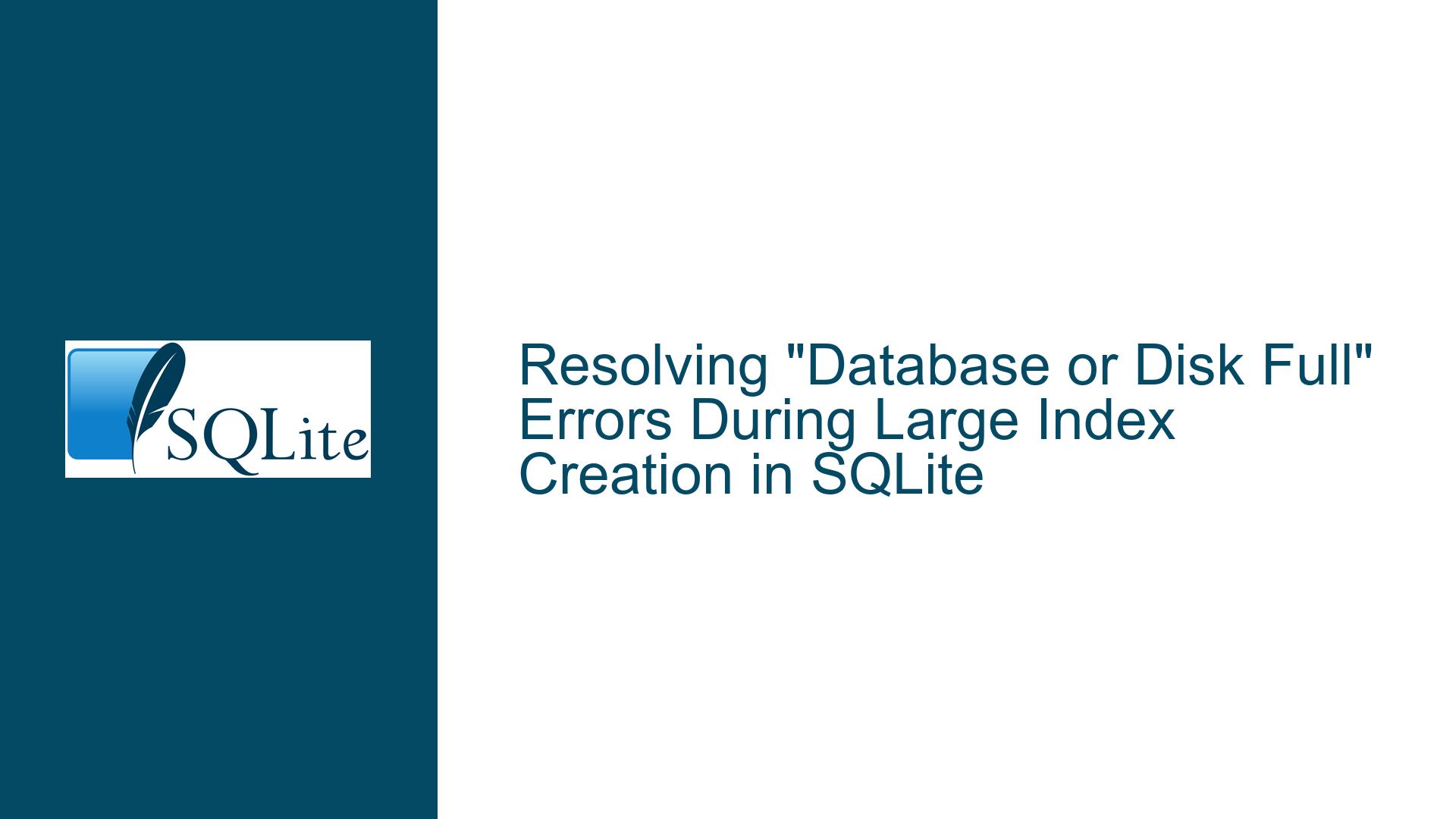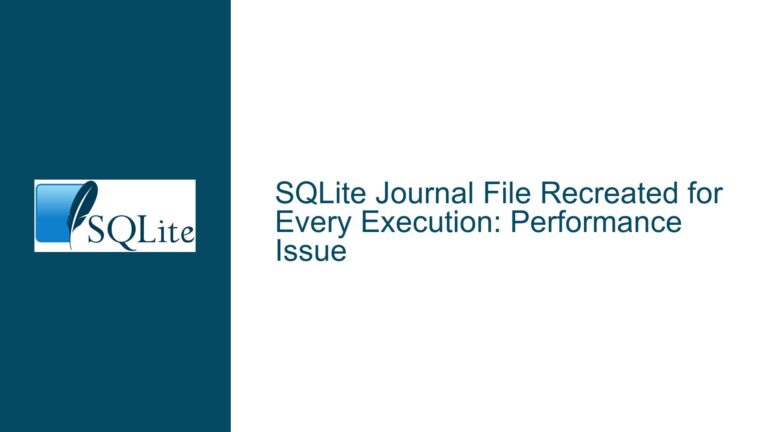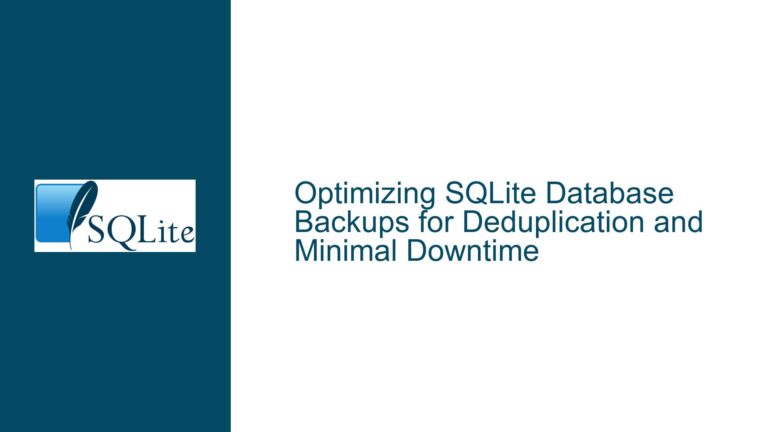Resolving “Database or Disk Full” Errors During Large Index Creation in SQLite
Understanding Storage Allocation Failures During Index Creation on High-Volume Tables
The error message "database or disk is full" in SQLite typically indicates that the operation being performed requires more storage space than is available. However, in cases where the physical disk has ample free space, the root cause is often related to SQLite’s internal storage management mechanisms or environmental constraints. This issue is particularly common when creating indexes on tables with extremely large datasets (e.g., 100+ million rows), as index creation involves substantial temporary storage and metadata adjustments. Below, we dissect the technical landscape of this problem, its potential triggers, and actionable solutions.
Potential Triggers of Storage Allocation Failures in Index Creation Workflows
1. Insufficient max_page_count Allocation
SQLite databases are divided into fixed-size pages, and the max_page_count pragma defines the maximum number of pages the database file can contain. If the current page_count (number of pages used) plus the pages required for the new index exceeds the max_page_count limit, SQLite will throw a "disk full" error even if the physical disk has free space. This limit is a soft ceiling defined at the database level and is often overlooked when scaling operations.
2. Misconfigured page_size and Its Impact on Index Size
The page_size pragma determines the size of each database page, which directly affects how efficiently data and indexes are stored. A smaller page_size (e.g., 4096 bytes) reduces the fan-out of index nodes, increasing the total number of pages required to store the index. If the page_size was not optimized before database creation or vacuuming, index operations may demand disproportionately more pages than anticipated, leading to allocation failures.
3. Temporary Storage Constraints During Index Construction
Index creation in SQLite involves writing temporary data to disk or memory, depending on the temp_store pragma setting. If the temporary storage location (e.g., the system’s temp directory or an in-memory buffer) lacks sufficient space, the operation will fail. This is exacerbated when the temporary storage resides on a separate volume with size restrictions (e.g., a RAM disk with a fixed capacity) or is subject to interference from external software like antivirus tools.
4. Filesystem Limitations on File Size or Fragmentation
Certain filesystems impose strict limits on maximum file sizes. For example, FAT32 restricts individual files to 4 GB, which can be insufficient for large SQLite databases or their temporary files. Additionally, filesystem fragmentation may prevent SQLite from extending the database file even if free space exists, as contiguous blocks are unavailable.
5. Antivirus or Security Software Interference
Real-time antivirus scanners may lock or delay access to temporary files created during index construction, causing SQLite to misinterpret the interruption as a storage exhaustion event. This is particularly problematic when the temp directory is actively monitored by security tools.
6. Unaccounted Overhead from Existing Data and Indexes
The base table’s existing size and structure (e.g., variable-length VARCHAR columns) influence the storage required for new indexes. Large values in the indexed column (columnA in this case) increase the size of index entries, reducing the number of entries per page and inflating the total page count needed.
Diagnostic Workflow and Remediation Strategies for Index Creation Failures
Step 1: Validate Database Configuration Settings
Begin by confirming the effective page_size, page_count, and max_page_count using the following commands:
PRAGMA page_size; -- Returns current page size (e.g., 8192)
PRAGMA page_count; -- Returns current number of pages used
PRAGMA max_page_count; -- Returns the maximum allowed pages
- Critical Analysis:
- If
page_sizeis smaller than the default 4096 bytes, consider recreating the database with a largerpage_size(e.g., 8192 or 16384) to improve index efficiency. Note thatpage_sizecan only be changed viaVACUUMor during database creation. - Calculate the theoretical maximum database size:
page_size * max_page_count. For example,8192 * 2147483646 ≈ 17.6 TB. If this value is smaller than the anticipated size of the database plus the new index, adjustmax_page_countupward usingPRAGMA max_page_count = NEW_VALUE;.
- If
Step 2: Estimate Index Storage Requirements
Use SQL queries to gauge the storage demands of the index:
SELECT COUNT(*), AVG(LENGTH(columnA)) FROM my_table;
- Critical Analysis:
- Multiply the average length of
columnAby the row count to estimate the total bytes needed for the index keys. For example, 107 million rows with an average key size of 64 bytes would require ~6.8 GB for keys alone. - Factor in SQLite’s B-tree overhead: Each index entry requires approximately 8 bytes of overhead (for pointers and metadata). For 107 million entries, this adds ~856 MB.
- Divide the total estimated size by the
page_sizeto determine the approximate number of pages the index will consume. If this exceeds the remainingmax_page_countheadroom (max_page_count - page_count), increasemax_page_countaccordingly.
- Multiply the average length of
Step 3: Inspect Temporary Storage Configuration
Check the temp_store pragma to determine where temporary files are stored:
PRAGMA temp_store; -- 0 = default, 1 = file, 2 = memory
- Critical Analysis:
- If
temp_storeis set to 0 (default) or 1, SQLite uses the system’s temp directory for temporary files during index creation. Verify that this directory has sufficient space (at least 2x the database size) using OS-level tools. - If the temp directory is on a separate filesystem (e.g., a RAM disk), ensure it can accommodate the temporary files. For large operations, consider redirecting temp storage using the
SQLITE_TMPDIRenvironment variable or reconfiguringtemp_storeto use memory (PRAGMA temp_store = 2;), provided the system has enough RAM.
- If
Step 4: Verify Filesystem Compatibility and Free Space
- Action:
- Confirm the filesystem type (e.g., NTFS, ext4, FAT32) using OS utilities. For Windows, run
fsutil fsinfo volumeinfo C:; for Linux, usedf -T /path/to/database. - Ensure the filesystem supports large files (e.g., FAT32 cannot handle files >4 GB). Migrate the database to a filesystem with appropriate limits if necessary.
- Check for filesystem fragmentation using tools like
defrag(Windows) ore4defrag(Linux). Defragmentation may free contiguous space for database expansion.
- Confirm the filesystem type (e.g., NTFS, ext4, FAT32) using OS utilities. For Windows, run
Step 5: Address External Software Interference
- Action:
- Temporarily disable antivirus or endpoint protection software and retry the index creation. If successful, add the database directory and system temp directory to the antivirus exclusion list.
- For enterprise environments, coordinate with IT security teams to whitelist SQLite processes or directories.
Step 6: Optimize Index Creation for Large Datasets
If the above steps fail, consider alternative strategies:
- Batch Indexing:
Split the table into smaller chunks (e.g., by ranges ofROWID) and create partial indexes incrementally. This reduces the temporary storage burden.CREATE INDEX my_index_part1 ON my_table (columnA) WHERE ROWID BETWEEN 1 AND 1000000; -- Repeat for subsequent rangesCombine partial indexes afterward (note: this requires application-level query adjustments).
- Schema Optimization:
IfcolumnAcontains redundant or compressible data (e.g., URLs with common prefixes), preprocess the data to store shorter identifiers or hashes instead. - In-Memory Indexing:
For systems with ample RAM, create a temporary in-memory database (:memory:), copy the table data, build the index there, and export the indexed data back to the main database.
Step 7: Rebuild the Database with Optimal Settings
For long-term stability, recreate the database with settings tailored for large-scale operations:
- Set
page_sizeto 8192 or 16384 during database creation. - Predefine a generous
max_page_countbased on growth projections. - Use
VACUUMperiodically to reclaim space and align data with the configuredpage_size.
By systematically addressing these factors—database configuration, temporary storage, filesystem constraints, and external interference—developers can resolve "database or disk is full" errors and successfully create indexes on high-volume tables. The key lies in preemptive configuration for scale and rigorous validation of environmental constraints.






